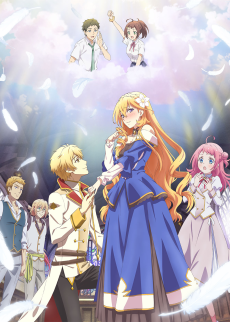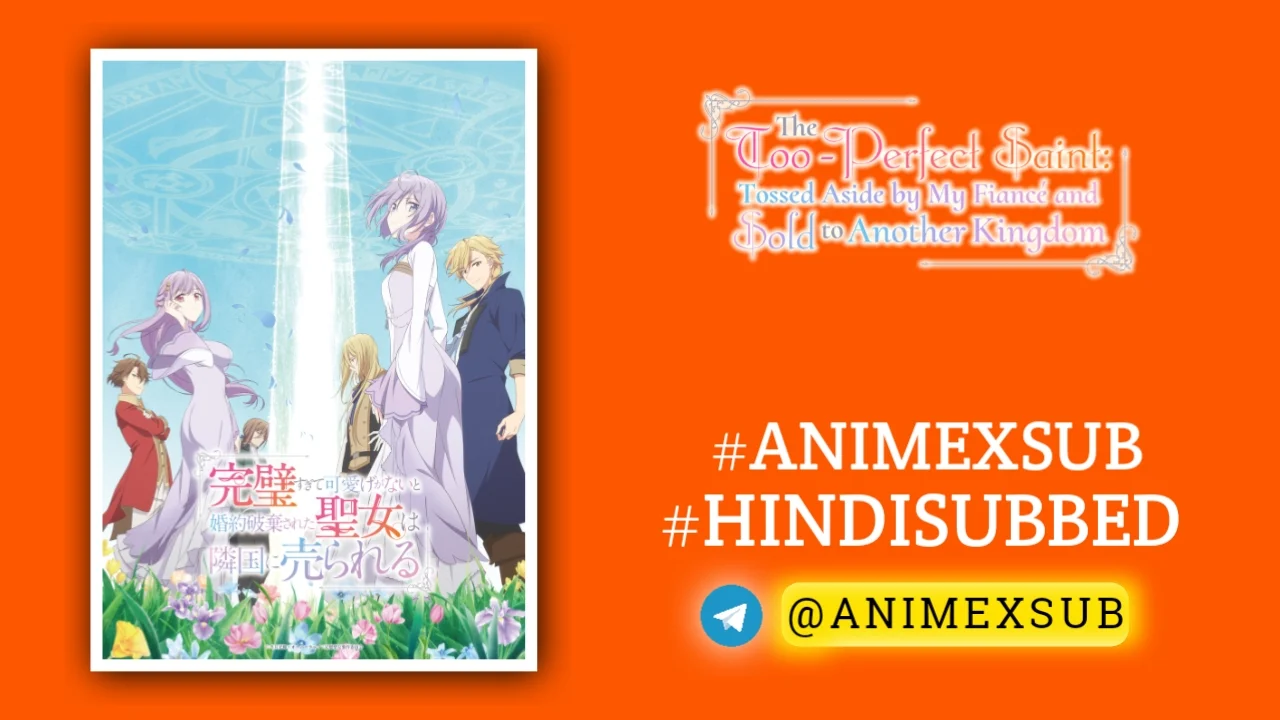
Endo and Kobayashi Live! The Latest on Tsundere Villainess Lieselotte Hindi Subbed [12/12] {Complete}

Tsundere Akuyaku Reijou Liselotte to Jikkyou no Endou-kun to Kaisetsu no Kobayashi-san
Endo and Kobayashi Live! The Latest on Tsundere Villainess LieselotteSynopsis
Endo and Kobayashi love to bicker about their latest video game fixation. They think they're simply providing color commentary, but one of the game’s characters, Siegwald, can hear them talking about his fiancée, the villainess Lieselotte! (Source: HIDIVE)
Watch Trailer
Characters
Echoes from the Screen: Unveiling the Hidden Heart of a Cursed Otome World
In the labyrinth of modern anime, where isekai tropes clash like swords in a forgotten coliseum, Endo and Kobayashi Live! The Latest on Tsundere Villainess Lieselotte emerges as a symphony of subversion. Season 1, a 12-episode odyssey aired from January 7 to March 25, 2023, by Tezuka Productions, doesn’t hurl its protagonists into another realm but flips the script: two ordinary high schoolers become unwitting deities, their banter piercing the veil of a digital fantasy. This isn’t mere escapism; it’s a meta-meditation on misunderstanding, where commentary becomes prophecy, and a villainess’s thorns reveal blooming vulnerability. Drawing from Suzu Enoshima’s light novel, the series crafts a narrative that feels like a live-streamed rebellion against otome game fatalism, blending humor, heartache, and harmony in ways that echo the soul’s quiet cries for connection.
Whispers of Fate: The Core Essence That Binds Real and Virtual Realms
At its nucleus, the story orbits around Shihono Kobayashi and Aoto Endo, broadcasting club comrades whose casual playthrough of Love Me Magically! (or MagiKoi) unravels cosmic threads. Kobayashi, the fervent analyst with an encyclopedic grasp of the game’s lore, idolizes Lieselotte Riefenstahl—the archetypal “villainess” doomed to possession by the Witch of Yore and a tragic demise across every route. Endo, initially skeptical, uncovers Lieselotte’s tsundere facade through supplementary materials: her sharp barbs mask profound affection and insecurity, born from a lineage of stoic Magic Knights and a fear of unworthiness. Their live commentary—Endo as the energetic play-by-play caller, Kobayashi as the insightful color expert—transcends the screen when Prince Siegwald Fitzenhagen, Lieselotte’s oblivious fiancé, hears them as divine voices from the heavens.
This premise, a fresh twist on the villainess isekai genre popularized by titles like My Next Life as a Villainess, explores themes of perception and redemption with surgical precision. No one is transported or reincarnated; instead, the “game world” evolves organically, deviating from scripted tragedy toward uncharted joy. Key motifs include the fragility of communication—how words, whether godly or gamer—can rewrite destinies—and the parallel journeys of love: Siegwald’s awakening to Lieselotte’s true self mirrors Endo’s budding feelings for Kobayashi, healed from his baseball injury’s shadow. The Witch of Yore isn’t just a monster but a symbol of suppressed emotions, her miasma feeding on doubts that the characters must collectively exorcise. This layered storytelling elevates the series beyond rom-com fluff, probing how empathy bridges worlds, real or rendered.
Voices of Divinity: The Ensemble That Dances on the Edge of Doom
The cast pulses with life, each character a facet of emotional depth rarely seen in otome adaptations. Lieselotte, voiced by Tomori Kusunoki with a pitch-perfect blend of venom and velvet, is the season’s crown jewel—a towering noblewoman whose “foul” exterior crumbles into adorable flusters, like steam-venting teapots during Siegwald’s compliments. Her cousin Baldur Riefenstahl (Tomokazu Sugita), the heroic knight burdened by sacrificial fates, evolves from stoic guardian to tender protector of Fiene, the game’s original heroine (Miyu Tomita), whose commoner magic and hidden royal lineage add intrigue. Siegwald (Yūichi Nakamura), the prince who starts as a dense archetype, transforms through the “gods'” guidance, his earnest confessions becoming pivotal in averting catastrophe.
In the real world, Endo (Kaito Ishikawa) and Kobayashi (Kana Hanazawa) anchor the human element. Endo’s arc, from injury-haunted withdrawal to confident broadcaster, parallels the game’s redemptions, while Kobayashi’s unyielding passion for Lieselotte reveals her own vulnerabilities—her enthusiasm as a shield against loneliness. Supporting players like the arrogant professor Leon Schache (Taku Yashiro) and the enigmatic Elizabeth enrich subplots, their confessions weaving a tapestry of multiple romances that culminate in unity against the witch. This ensemble avoids clichés by grounding tropes in psychology: tsundere traits stem from trauma, not convenience, making every outburst a revelation.
Chronicles of Intervention: A Journey Through Twelve Pivotal Chapters
Season 1 unfolds as a meticulously paced chronicle, each episode a chapter in the dual narratives of salvation and self-discovery. Here’s a distilled overview, highlighting transformative moments without spoiling the emotional crescendos:
- Chapter 1: The Tsundere, the Prince, and the Voices of the Gods – Kobayashi drags Endo into MagiKoi, their banter igniting the anomaly. Siegwald’s first “divine” hearing sets the stage, blending school life with fantasy intrigue.
- Chapter 2: The Wand, Maxed Out, and Favored by the Gods – Guidance begins; Siegwald deciphers Lieselotte’s ribbon-adorned wand as a love token, sparking her first genuine blush amid academy politics.
- Chapter 3: The Ribbon, the Upperclassman, and Feelings of Love – Baseball shadows Endo’s past as Lieselotte’s tsundere flares intensify. A ribbon exchange hints at deeper bonds, rated highly for its heartfelt parallels (6.5/10 on fan aggregates).
- Chapter 4: The Summer, Going Home, and Missing You – Fiene’s path diverges; Lieselotte invites her home, fostering unlikely friendships while Endo and Kobayashi’s sessions grow intimate (6.3/10).
- Chapter 5: Mother and Daughter, Sisters, and a First Date – Revelations about Fiene’s origins unfold, intertwining family secrets with budding romances. Elizabeth’s tales add mythic depth (6.4/10).
- Chapter 6: A Nightmare, the Coward, and the Princess Carry – Fiene hears the voices, escalating stakes. Nightmares plague Lieselotte, testing loyalties in a whirlwind of confessions (6.4/10).
- Chapter 7: The Prophecy, the Little Boy, and the Live Broadcast – Prophecies loom; Siegwald affirms his love, sending Endo and Kobayashi into ecstatic frenzy amid witch omens (6.3/10).
- Chapter 8: Master and Disciple, the Mask, and Tsundereally-Pissed – Baldur vows to confront the witch; Leon’s conflicted adoration for Elizabeth shines, blending mentorship with masked emotions (6.3/10).
- Chapter 9: The Dress, the School Festival, and Overflowing Emotions – Lieselotte asserts herself at the festival; Endo voices anxieties, mirroring real-world growth (6.2/10).
- Chapter 10: The Lirene Flower, the Ball, and the Witch – Gratitude Festival reconfirms bonds; the witch’s shadow encroaches, heightening urgency (6.2/10).
- Chapter 11: The Witch, the Goddess, and the Creation Myth – Climactic confrontation; love’s power clashes with ancient miasma, revealing creation lore (6.1/10).
- Chapter 12: The Best Happy End to End All Happy Ends! – Proposals and resolutions seal fates; a meta-twist ties real and virtual, delivering cathartic closure (6.4/10 overall season average on IMDb).
These episodes, each around 24 minutes, build tension like a commentary stream hitting peak hype, with deviations from the source material—like added broadcasting club dynamics—enhancing accessibility.
Symphonies of Affection: Multiple Romances That Resonate Across Dimensions
What elevates Season 1 is its orchestration of polyphonic love stories, each a counterpoint to the others. The central duo, Siegwald and Lieselotte, evolves from scripted doom to authentic passion—his realization of her “overwhelming adorableness” dismantles villainess tropes, showing how miscommunication dooms even the purest hearts. Fiene and Baldur’s protector-ward dynamic blooms into mutual strength, subverting the heroine’s harem fate into a grounded partnership. Subtler threads, like Leon’s adoration for mentor Elizabeth or young Fabian’s innocent crush, add emotional breadth without overwhelming the core.
Parallel to this, Endo and Kobayashi’s slow-burn romance—fueled by shared sessions and her subtle wingman clubmates—mirrors the game’s themes. His injury’s emotional scars heal through her voice-loving invitation, culminating in confessions that feel earned, not contrived. This duality critiques otome conventions: why must love be zero-sum? Here, it’s multiplicative, with every pairing reinforcing communal triumph over isolation. The animation captures these nuances vividly—flushed cheeks, lingering gazes—making hearts race in stereo.
Forged in Code and Commentary: Production That Captures Ethereal Magic
Tezuka Productions delivers a visually enchanting adaptation, with Miyuki Katayama’s character designs blending ethereal fantasy elegance and relatable high school charm. Direction by Fumihiro Yoshimura maintains a rhythmic flow, intercutting game and real-world scenes like seamless edits in a Let’s Play video. The soundtrack, composed by Tatsuhiko Saiki and others (veterans of villainess tales), weaves whimsical flutes for tsundere moments with ominous swells for witch threats, amplifying emotional highs. Dazbee’s opening “Ibitsu na Kotoba” pulses with distorted romance, while Anna’s ending “Like a Flower” evokes fragile blooming—perfectly thematic.
Voice acting shines: Kusunoki’s Lieselotte shifts from icy snaps to molten warmth, Nakamura’s Siegwald from princely poise to fervent awe. Inconsistencies in real-world animation (noted in reviews as dips in fluidity) are minor compared to the fantasy sequences’ polish, where magical auras and festival lights dazzle. Adaptations from the light novel and manga add fresh layers, like expanded club interactions, without diluting the source’s wit. Overall, it’s a technical triumph that honors the meta-narrative, streaming flawlessly on HIDIVE for global audiences.
Echoes of the Heart: Critical Acclaim and Viewer Reverberations
Reception for Season 1 has been a chorus of praise for its innovative premise, though not without harmonious critiques. On MyAnimeList, it holds a solid 7.2/10 from over 50,000 users, lauded for character-driven romance and subversion of isekai fatigue. IMDb mirrors this at 6.4/10, with fans highlighting the “feel-good” vibes and multi-couple dynamics as underrated gems. Anime News Network’s preview guide calls it a “slam dunk” for villainess enthusiasts, appreciating how it invites viewers into fanon reinterpretations. The New Leaf Journal review praises the concept’s affection for characters but notes underdeveloped real-world arcs and animation variances, scoring it as “generally enjoyable” despite faults.
Reddit threads and Beneath the Tangles essays delve deeper, analyzing themes of faith and translation in relationships—Siegwald’s trust in “gods” as a metaphor for vulnerability. Critics like those on CBR commend its explanation of tsundere psychology, rare in anime, while some lament the manga’s 2024 cancellation due to editorial issues, positioning the anime as the definitive medium. Positively, it’s hailed as a “must-watch for shoujo/romance fans,” with zero promotional hype needed—its purity lies in genuine emotional resonance. Drawbacks? Pacing can feel commentary-heavy early on, and side plots occasionally overshadow the witch arc, but these enhance replay value.
Eternal Broadcast: Why This Tale Endures Beyond the Credits
Endo and Kobayashi Live! Season 1 isn’t just an anime; it’s a testament to storytelling’s alchemical power—turning pixels into prophecies, barbs into ballads. In a genre saturated with portals and possessions, it stands as a beacon of meta-mastery, where saving a fictional soul heals real ones. Lieselotte’s journey from doomed dame to devoted bride, intertwined with Endo’s liberation, reminds us: true epics aren’t about conquests, but connections forged in understanding. As the credits roll on this harmonious finale, one can’t help but wonder—what if our own unspoken words could rewrite the stars? This series, with its unyielding heart and innovative soul, ensures its broadcast echoes eternally.

















